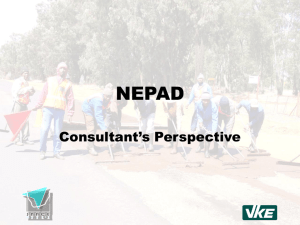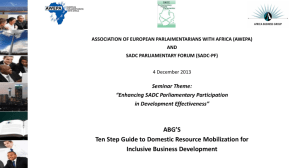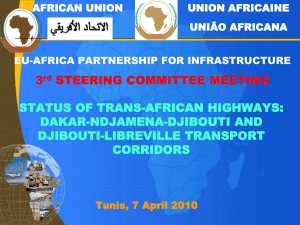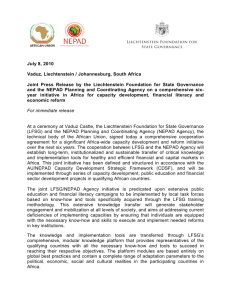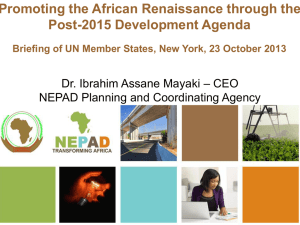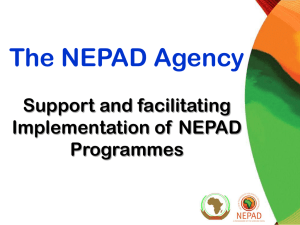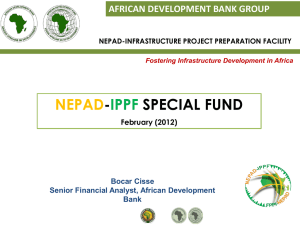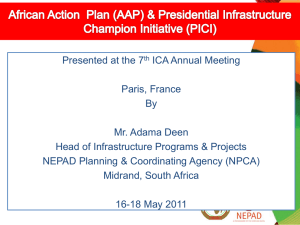Ijeoma_Eval Dvlpment Proj in Africa NEPAD CS
advertisement
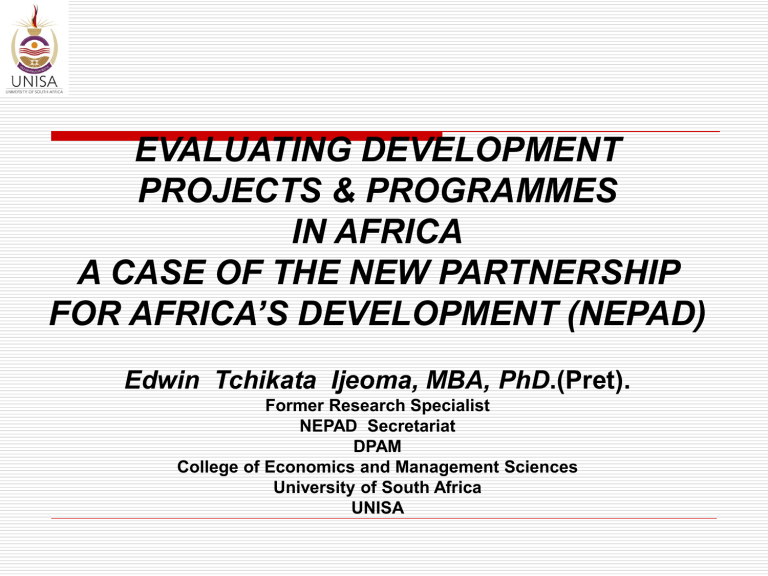
EVALUATING DEVELOPMENT PROJECTS & PROGRAMMES IN AFRICA A CASE OF THE NEW PARTNERSHIP FOR AFRICA’S DEVELOPMENT (NEPAD) Edwin Tchikata Ijeoma, MBA, PhD.(Pret). Former Research Specialist NEPAD Secretariat DPAM College of Economics and Management Sciences University of South Africa UNISA PRESENTATION OUTLINE 1.INTRODUCTION • Evaluation of NEPAD • NEPAD background and prospects • Why NEPAD • NEPAD strategic objectives 2. CONDUCTING EVALUATION IN AFRICA • Origin • Constraint • Complexities 3. EVALUATION PROVIONS ON NEPAD • Factors that encourage and discourage compliance on international agreements/practices • Encourage factors • Discouraging factors PRESENTATION OUTLINE (continue) 4. • • • • CONTEXUALISING THE NEPAD EVALUATION PROCESS APRM Assessment of evaluation content of NEPAD Benchmarking the NEPAD evaluation process Guides to NEPAD Evaluation INTRODUCTION The current levels of the NEPAD service delivery and projects implementations is not adequate towards bringing about growth in the economy of African Union member Countries Achieving the MDGs by 2015 may be a goose chase if measures are not put in place to evaluate the performance of NEPAD projects and programmes. PRESENTATION OUTLINE (continue) 5.EXAMPLES OF THE NEPAD EVALUATION DEMAND • Six milestones • Six projects • Six expected deliverables 7.MONITORING & EVALUATION DONOR PERPECTIVES 8.MONITORING & EVALUATION AFRICAN PERSPECTIVES NEPAD: BACKGROUND AND PROSPECTS Presidents Mbeki of South Africa and Wade of Senegal proposed two initiatives the New Millennium for African Recovery Programme [MAP] and the Omega Plan [OP] respectively. THE REC’S IN AFRICA Central to the NEPAD framework is the need for African countries to pool their resources together. strengthening the five Sub-Regional •SADC, •MAU, •ECOWAS, •CENSAD •EEC The NEPAD evaluation system has not been implemented at any level of the initiative except on issues of its partnership with development agencies whose operational procedures require evaluation process. An effective system of •regulation, •continuous evaluation, and •close monitoring are essential to the success of NEPAD • draw conclusions and •make judgments on the outcomes or impact of the Review Procedures for appointing the APRM Mgt. •The same political leaders •Not transparent •Political manipulations •Need organizational focus on day-today running of NEPAD Secretariat ,its projects and programmes elsewhere in Africa. THE NEED FOR NEPAD • the need to address the deep dissatisfaction According to the World Bank report most notable among these reforms is the International Monetary Fund (IMF) and the World Bank approved stabilization and structural adjustment programme (SAP). Poverty is rife in Africa where about half of the total population lives on less than US $1 per day. Furthermore, in the past two decades, economic growth across Africa has lagged behind NEPAD Strategic Objectives • • • • • • • • African ownership and responsibility, promotion of self-reliance, democratic principles, human rights, the rule of law and good governance, promotion of gender equality, respect for sanctity of human life, promotion of social justice and fostering a new relationship with the developed countries that would be based on mutual respect and • responsibility and accountability. NEPAD IDENTIFICATION OF COMMON CONCERNS Infrastructure Inter-linkages within Africa: Encouraging Capital Flows Within Africa: Common and Coordinated Regulatory Frameworks: Complementary and/or Combined Cross-Border Production: Agricultural Development & Food Security: The African Debt Problem: CONDUCTING EVALUATION IN AFRICA: ORIGIN, CONSTRAINTS AND COMPLEXITIES Origin •The first continental body for evaluation, the African Evaluation Association •AfrEA was established in 1999. •first conference in Nairobi in 2002 •second in Cape Town in 2004 •The aim of AfrEA to promote the M&E agenda in Africa and to promote participatory workshops. Since the inception of the association, practitioners would want to see its recommended M&E applications in use in many African countries. That would be the first test of its acceptance by governments, development agencies, Non-governmental organizations and other stakeholders CONDUCTING EVALUATION IN AFRICA: ORIGIN, CONSTRAINTS AND COMPLEXITIES Constraints In most African countries: • • • • • • Fault-finding Negative Perceptions exposing and criticizing failures and weaknesses strengths and successes. Something to be feared or, at best tolerated M&E arena is donor-dominant and donor-driven countries and NGO’s depend heavily on World Bank loans CONDUCTING EVALUATION IN AFRICA: ORIGIN, CONSTRAINTS AND COMPLEXITIES Constraints (continue) •Programmes in African usually come with evaluation requirements; • Non-availability of fund •High cost of evaluation •The government role in fostering learning on projects and programmes is neglected; • that the under-utilization or non-utilization of M&E findings •lack of feedback mechanisms • lack well-organized and coordinated information systems Complexities •Problem of determining the appropriate variables to use to represent such performance measures as benefits and costs (or gains and losses) •variables considered as gains and losses are not easily quantifiable and thus immeasurable. •M&E is more recognized within the private sector environment in Africa than the public sector. Most African public sector institutions comply with M&E process on those projects and programmes where M&E is a prerequisite for donor funding • THE NEPAD M&E BACKGROUND •the Lagos Plan of Action, and Final Act of Lagos (1980); • the African (Banjul) Charter on Human and Peoples’ Rights (1981); • the African Charter for Popular participation in Development (19190); • the declaration on the political and socio-Economic situation in Africa and the Fundamental Changes taking Place in the world(1990) and • the African Charter on the Rights and Welfare of the Child (1990). • the Abuja Treaty establishing the African Economic Community (1991) • the 1993 Cairo Declaration Establishing the Mechanism for conflict Prevention, Management and Resolution; • the Protocol on the Establishment of African Court on Human and People’s Rights (1998); • the 1999 Grand Bay (Mauritius) Declaration and Plan of Action for Promotion and Protection of Human Rights; • the Framework for an OAU Response to Unconstitutional Changes of Government (adopted at the 2000 OAU Summit in Lomo, Togo, and based on eelier decision of the 1999 Algiers OAU Summit; and • the Conference on Security, Stability, Development and Cooperation Factors that Encourage and/or Discourage Compliance in International Agreements by African States Encouraging Factors • Agreements that are relevant to the social needs and aspirations • Reasonable degrees of understanding and general commitment in law, agreements and treaties • Presence of institutions for law enforcements that have the capacity to enforce the agreements • The presence of the critical mass of professionals in the various organs of the institutions for enforcing agreements • The existence of organized and active formations in civil society, Discouraging Factors •Exclusion or marginalization and inequality among states • Lack of capacity in the political, social sectors on the part of the states, • Deliberate breach of the agreement by the state, often informed by the calculated risks of not being caught or punished; • Conscious decision not to comply because of real or perceived unreasonableness or unfairness of the agreement/treaty; • Irresponsibility by the political leadership and other managers of state affairs as a result of corruption, negligence, lack of patriotism and the presence of the culture of lawlessness; • Weak incorporation of international agreements in the domestic or national popular domestic space; • Lack of knowledge and hence lack of ownership and oversight by the general public about agreements entered into by the states and • Lack of existence and /or efficacy of external enforcement mechanisms and effective sanctions. CONTEXTUALISING THE NEPAD EVALUATION PROCESS • Democracy and Good political governance; • Economic and Corporate Governance; • Socio-Economic Development and • African Peer-Review Mechanism (APRM). The APRM Mandate The mandate of the RM is to ensure that the policies and practices of the participating countries conform to the agreed political, economic and corporate governance values, codes and standards contained in the Declaration on Democracy, political, Economic and Corporate Governance. The APRM is a mutually agreed instrument for self-monitoring by the participating member governments. The APRM Primary Objectives The primary purpose of the APRM is to foster the adoption of policies, standards and practices that lead to political stability, high economic growth, sustainable development and accelerated sub-regional and continental economic integration through sharing of experiences and reinforcement of successful and good practices, including identifying deficiencies and assessing the need for capacity building. APRM Principles Every review exercise carried out under the authority of the Mechanism must be technically competent, credible and free of political manipulations. These stipulations together constitute the core guiding principles of the APRM. Assessment of the Evaluation Content of NEPAD The analysis on the NEPAD evaluation process and its provisions in the NEPAD documents tend to focus on issues of •codes and standards and •African Peer Review Mechanism. •APRM seem to be an outstanding instrument for NEPAD Benchmarking the NEPAD Evaluation Process • the level of domestic and foreign direct investments (separating those influences by the NEPAD initiative and those that are not influenced by NEPAD); • the rise and fall of trade and capital flows since market access is a key NEPAD goal; • African standard of living as measured by Human development index e.g. the use of NEPAD as an election issue in African states; • number of states subscribing to the APRM or those failing in the review process; • level of corruption, political freedom in African countries; • an assessment of democratization of government and human rights abuse; • progress in the consolidation of the existing Regional Economic Communities from seven to five envisaged under the NEPAD framework. M & E TO IMPROVE NEPAD INITIATIVE • Substantive government demand is a prerequisite for successful • • • • • • • • • • institutionalization Role of incentives Key role of a powerful ‘champion’ Start with a diagnosis of existing M&E Centrally-driven, by capable ministry Build reliable ministry data systems Danger of over-engineering the system Utilization is the measure of ‘success’ Limitations of relying on government laws, decrees and regulations Role of structural arrangements to ensure M&E objectivity and quality A long-haul effort, requiring patience OTHER FACTORS FOR IMPROVEMENT • Incentives are an important part of the demand side • No government build M&E systems because of intrinsic merit • Another dimension to the demand side • Creating a comprehensive M&E systems • Stewardship of the process COMMON MISTAKES ON MONITORING EVALUATE • Over-engineering the system • Unclear performance indicators • Information breakdown • Poor quality of data • Limitations of discipline • Structural arrangements M&E DONOR PERSPECTIVES • Dependent on international aid • Strong accountability pressure on donors for results • Increase in the level of donor involvement • Increase in the number of evaluation institutions AFRICAN PERSPECTIVES • too rigid and too political • meet for sound evaluation information • poverty & desease • debt reduction a forgiveness • reliance on donor for evaluation work AFRICAN PRSP PREPARATIONS •Financial management information systems – to support better financial tracking • Public expenditure tracking surveys – these enable ‘leakage’ or the effects of corruption to be traced • Service delivery surveys • Rapid appraisals – for example, of ‘problem’ projects or programs • National and sectoral statistical collections – especially relating to national priorities such as the MDGs • Sector ministries’ administrative data WAY FORWARD • Demand is weak but we need to strengthen the work • Evaluation associations has a huge role to play • Highly influential evaluation may be more persuasive Example of the possible NEPAD Projects Evaluation (Milestones, Expected deliverables and Executioners) Milestones NEPAD Projects/Expected Deliverables Executioner Milestone 1 To evaluate and assess measures and instruments currently used by various global and regional development agencies on their programmes and activities in Africa. Monitoring & Evaluation Strategists/ Experts To develop an African own measures and instruments for assessing the impacts of (donors) development partners, agencies and institutions in African countries. Mile stone 2 To develop measures and instruments for assessing the impacts of the NEPAD programmes in all African Union countries. Milestone 3 To develop measures and instruments for assessing countries and regional capacities to respond to major NEPAD programmes. Milestone 4 To facilitate establishment of an African High-level Voluntary Service that will comprise of Retired African Leaders, Heads of States, Statesmen and women, Role models with good Milestones NEPAD Projects/Expected Deliverables Executioner Milestone Five To initiate an effective feedback Communication Strategy that will have country and Continentwide coverage for disseminating Africa’s socioeconomic development information on a quarterly basis. Monitoring and Evaluation Strategists/Experts “ NEPAD Project Evaluation Insight” may be established aimed at profiling socio-economic projects and programmes taking place in African countries, regions under the NEPAD programmes. To avoid the current patterns of backlogs being experienced in Project and programmes evaluation of NEPAD. The journal will lay greater emphasis on the prospects, challenges, innovation, creativity and sum-total of successes, failures and lessons learnt in the process. The journal will also give regular common position of African country’s opinion on several continental and global issues. Milestone Six To facilitate outcome-based Working Relations Between the AU Commission and the NEPAD Secretariat Paragraph 9(iii) of the Maputo Declaration requires that the working relations between the AU Commission and the NEPAD Secretariat, especially for programme coordination and harmonisation, be formalised. Institutionally, the structure of the AU Commission provides for a NEPAD Coordinating Unit in the Office of the Chairperson of the AU Commission to be staffed by not more than five officers. . The implementation of this proposal will place emphasis and priority on ensuring efficient and effective reporting and communication between the Commission and the NEPAD Secretariat. Formalising the relations between the AU and NEPAD programmes need to take into considerations the programmes of the Commission as approved by the Maputo Summit, especially those of the eight portfolios, on the one hand, and those of NEPAD as contained in the NEPAD Initial Action Plan and subsequent approvals by the HSGIC, on the other hand. As a way forward, there is a need for development of mechanisms for institutionalised consultations and engagement between NEPAD Secretariat and AU Commission will enhance mutual understanding between staff and officers of the two institutions. THANK YOU
